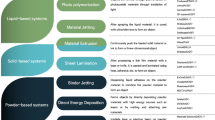The experience gained in manufacturing complex ceramic parts using additive technology LCM (Lithography-based Ceramic Manufacturing) and an analysis of the economic expediency of using this technology in serial and experimental manufacturing of ceramic parts as compared with slip casting technology are presented. The results are of interest in developing and manufacturing new, complex, experimental, ceramic parts and selecting a technology and equipment for serial production.






Similar content being viewed by others
References
V. Yu. Krakhmatova, A. I. Zakharov, D. V. Andreev, and A. F. Krivoshchepov, “Methods of additive technologies for the manufacture of ceramic products (Review),” Steklo Keram., No. 12, 26 – 33 (2018); V. Yu. Krakhmatova, A. I. Zakharov, D. V. Andreev, and A. F. Krivoshchepov, “Methods of additive technologies for the manufacture of ceramic products (Review),” Glass Ceram., 75(11 – 12), 479 – 484 (2018).
M. A. Zlenko, A. A. Popovich, and I. N, Mutylina, Additive Technologies in Machine Engineering [in Russian], SPbGU, St. Petersburg (2013).
S. A. Filatov, “Additive technologies: current status and prospects,” in: Prospects of Development of Additive Technologies in Belarus [in Russian], Minsk (2017), pp. 115 – 117.
V. V. Promakhov, I. A. Zhukov, and S. A. Vorozhtsov, “Additive method of forming articles from powders of refractory compounds,” Polzunovskii Vest., 1(4), 59 – 63 (2016).
M. Zlenko and P. Zabednov, “Additive technologies in experimental casting manufacturing. Pt. 1. Casting metals and plastics using synthesis-models and synthesis-molds,” Metall. Mashinostr., No. 2, 45 – 54 (2013).
The authors thank N. M. Sgonov, specialist at Energoavangard LLC (Moscow), for his active participation in this work.
Author information
Authors and Affiliations
Corresponding author
Additional information
Translated from Steklo i Keramika, No. 9, pp. 9 – 16, September, 2019.
Rights and permissions
About this article
Cite this article
Romanov, M.K., Zhuravleva, L.I. Analysis of the Technological and Economic Expediency of Using Additive Technologies in Manufacturing Ceramic Parts. Glass Ceram 76, 328–333 (2020). https://doi.org/10.1007/s10717-020-00194-8
Published:
Issue Date:
DOI: https://doi.org/10.1007/s10717-020-00194-8




